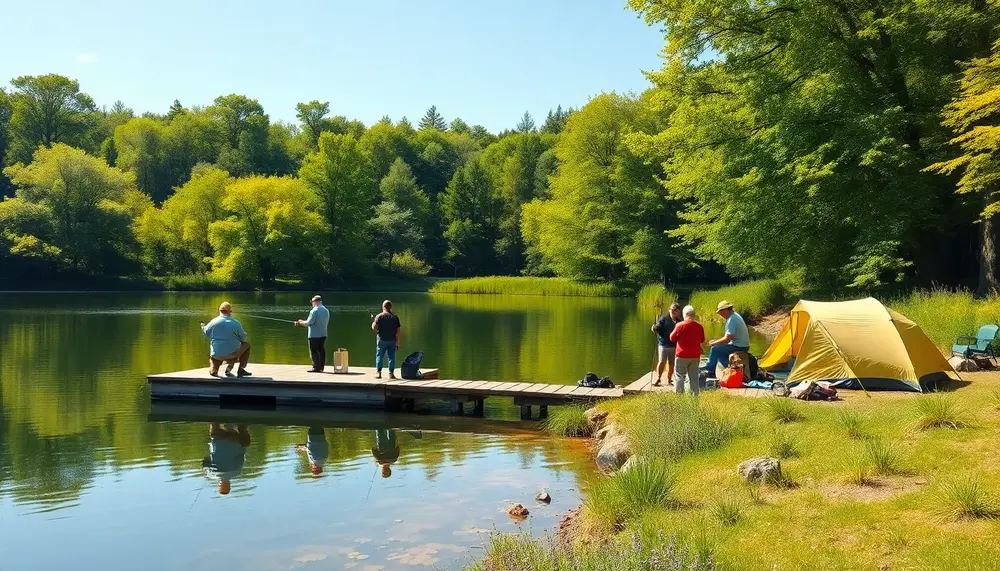Table of Contents:
How Sustainable Fishing Directly Reduces Climate Change Drivers
Sustainable fishing isn’t just about saving fish—it’s a hands-on approach to tackling the very roots of climate change. When fisheries operate responsibly, they avoid the overexploitation that leads to ecosystem collapse and, surprisingly, to higher greenhouse gas emissions. Overfishing often destroys the balance of marine food webs, which in turn disrupts the ocean’s natural ability to sequester carbon. In contrast, sustainable practices keep fish populations healthy, so marine ecosystems can continue their vital role as carbon sinks.
What’s less obvious: destructive fishing gear like bottom trawls churn up seabeds, releasing carbon stored in sediments straight into the water column and, eventually, the atmosphere. By switching to selective, low-impact gear, sustainable fisheries prevent this “carbon leak.” That’s a direct hit against one of the sneakiest sources of oceanic CO2 emissions.
Another point—sustainable fisheries minimize waste by targeting only what’s needed and reducing bycatch. Less waste means less energy spent on processing, transporting, and discarding unwanted catch, all of which contribute to emissions. Plus, healthier fish stocks mean less need for fuel-intensive fishing trips, as fishers don’t have to travel farther or fish longer to meet quotas.
In a nutshell, every responsible choice at sea—whether it’s gear selection, quota management, or protecting spawning grounds—directly chips away at the drivers of climate change. These aren’t just incremental tweaks; they’re fundamental shifts that keep both oceans and our climate system in balance.
Integrating Science-Based Fisheries Management to Lower Carbon Emissions
Integrating science-based fisheries management is a game-changer for lowering carbon emissions across the seafood sector. By using real-time data, predictive models, and ecosystem monitoring, managers can set catch limits and fishing seasons that align with both ecological health and climate goals. This isn’t just theory—evidence shows that adaptive, data-driven management reduces the risk of stock collapse, which often triggers desperate, fuel-intensive fishing efforts that spike emissions.
Science-based approaches also allow for:
- Dynamic closures: Temporarily shutting down certain areas when vulnerable species or habitats are at risk, which prevents unnecessary trips and wasted fuel.
- Spatial planning: Directing fishing activity away from carbon-rich habitats, like seagrass meadows or mangroves, that naturally lock away CO2.
- Realistic quotas: Setting harvest levels that reflect current stock assessments, so fleets don’t overshoot and cause population crashes that would require even more energy to recover.
When fisheries management is grounded in up-to-date science, it’s possible to anticipate environmental changes—like shifting fish distributions due to warming seas—and adapt before problems spiral. This forward-thinking mindset means less wasted effort, less fuel burned, and a measurable drop in the carbon footprint of fishing operations. It’s not magic, but it’s about as close as you get in the real world.
Restoring Marine Ecosystems as Natural Climate Solutions
Restoring marine ecosystems is not just a feel-good environmental project—it’s a strategic climate solution with real, measurable benefits. Healthy habitats like kelp forests, oyster reefs, and salt marshes capture and store vast amounts of carbon, often referred to as “blue carbon.” When these ecosystems are degraded by unsustainable fishing or pollution, their ability to lock away carbon plummets. But here’s the kicker: restoration efforts can rapidly reverse this trend, turning damaged seascapes back into powerful carbon sinks.
Targeted restoration projects deliver climate benefits by:
- Rebuilding habitat complexity: Structures like reefs and seagrass beds provide shelter for marine life and increase the area available for carbon storage.
- Enhancing biodiversity: Diverse ecosystems are more resilient to climate shocks and more effective at sequestering carbon over the long term.
- Stabilizing sediments: Root systems of seagrasses and salt marsh plants lock sediments in place, preventing the release of stored carbon back into the ocean and atmosphere.
In practice, restoring marine ecosystems goes hand in hand with sustainable fishing. When fishing pressure is reduced and habitats are allowed to recover, the climate payoff is significant. These natural climate solutions are cost-effective, scalable, and—unlike some high-tech fixes—come with a whole suite of co-benefits, from protecting coastal communities to boosting local economies. It’s a win-win, really.
Case Study: Sustainable Fisheries Supporting Coastal Resilience
Case Study: Sustainable Fisheries Supporting Coastal Resilience
In the small coastal town of Xai-Xai, Mozambique, local fishers faced a double threat: dwindling fish stocks and increased flooding from stronger storms. Instead of sticking to old routines, the community joined forces with marine scientists to implement a sustainable fisheries co-management plan. The approach was simple but powerful—seasonal closures, gear restrictions, and strict monitoring, all based on local ecological knowledge and scientific input.
- Reduced Vulnerability: As fish populations rebounded, so did the health of nearby mangrove forests, which act as natural barriers against storm surges and erosion. The improved ecosystem absorbed wave energy, lessening the impact of cyclones on homes and farmland.
- Economic Stability: Fishers saw steadier catches throughout the year, which meant less need to migrate or switch to riskier livelihoods. The reliable income allowed families to invest in storm-resistant housing and community infrastructure.
- Social Cohesion: The collaborative management process fostered trust between fishers, scientists, and local leaders. This unity proved invaluable during extreme weather events, enabling rapid response and recovery.
What stands out in Xai-Xai is how sustainable fisheries don’t just protect marine life—they build real-world resilience for people living on the frontlines of climate change.
Empowering Communities and Stakeholders for Climate Action
Empowering Communities and Stakeholders for Climate Action
Driving climate action through sustainable fishing isn’t a top-down affair—it thrives when local communities and stakeholders are front and center. Real progress happens when those who depend on the ocean are given the tools, knowledge, and authority to shape fisheries management and climate strategies themselves.
- Capacity Building: Training programs in climate-smart fishing techniques, ecosystem monitoring, and adaptive management equip fishers and local leaders to respond to changing ocean conditions.
- Inclusive Decision-Making: By integrating traditional knowledge with scientific expertise, communities co-create rules that are practical, enforceable, and respected. This sense of ownership leads to higher compliance and better outcomes for both people and the planet.
- Access to Resources: Support for small-scale fishers—such as microfinance, insurance schemes, and access to sustainable gear—reduces vulnerability to climate shocks and enables investment in long-term sustainability.
- Stakeholder Networks: Regional alliances and fisher cooperatives amplify local voices, facilitate knowledge exchange, and help secure policy changes that prioritize climate resilience.
When communities and stakeholders are truly empowered, climate action becomes embedded in daily life—transforming sustainable fishing from a policy goal into a lived reality.
Promoting Conscious Consumption to Amplify Climate Benefits
Promoting Conscious Consumption to Amplify Climate Benefits
Consumer choices have a surprising ripple effect on climate outcomes, especially when it comes to seafood. By opting for sustainably sourced fish, individuals send a direct market signal that encourages responsible production and discourages destructive practices. This isn’t just about reading labels—it's about demanding transparency and traceability throughout the supply chain.
- Market Incentives: Retailers and restaurants respond to consumer demand by prioritizing suppliers who meet rigorous sustainability standards, effectively raising the bar for the entire industry.
- Reducing Food Waste: Conscious consumers make informed purchasing decisions, buy only what they need, and use more of each fish, minimizing waste and the associated emissions from discarded seafood.
- Supporting Local and Seasonal Choices: Choosing locally caught, in-season fish reduces the carbon footprint linked to transportation and storage, while also supporting small-scale fishers who often use lower-impact methods.
- Education and Advocacy: Well-informed consumers become advocates, spreading awareness about the climate benefits of sustainable seafood and influencing friends, family, and policy makers.
Ultimately, every conscious seafood purchase is a small but meaningful step toward amplifying the climate benefits of sustainable fishing—proof that collective action starts at the dinner table.
Measuring the Climate Impact of Sustainable Fishing Practices
Measuring the Climate Impact of Sustainable Fishing Practices
Quantifying the climate effects of sustainable fishing is no small feat, but it’s essential for tracking progress and holding the industry accountable. The process relies on a mix of innovative technology, robust data collection, and interdisciplinary research—without which, claims of climate benefit would be little more than wishful thinking.
- Life Cycle Assessments (LCA): These comprehensive analyses calculate greenhouse gas emissions from every stage of the seafood supply chain, from gear manufacturing to final consumption. LCAs reveal the hidden climate costs and help pinpoint where sustainable practices make the biggest difference.
- Satellite and Remote Sensing: High-resolution imagery and ocean sensors track changes in marine habitats, biomass, and carbon storage, providing real-time feedback on the ecological outcomes of fishing practices.
- Onboard Monitoring Systems: Digital logbooks, electronic catch documentation, and fuel-use trackers enable precise measurement of emissions and resource use at the vessel level.
- Standardized Climate Metrics: The development of industry-wide benchmarks—such as “carbon per kilogram of fish landed”—allows for transparent comparison between fisheries and helps consumers make informed choices.
- Collaborative Research: Partnerships between scientists, fishers, and policymakers ensure that data is not only collected but also interpreted and applied in ways that drive real-world climate action.
Ultimately, robust measurement is the linchpin for scaling up sustainable fishing’s climate benefits—because what gets measured, gets managed.
FAQ: Sustainable Fishing and Climate Change
What is sustainable fishing, and how does it differ from conventional fishing?
Sustainable fishing uses science-based practices that prioritize healthy fish populations, responsible catch limits, and ecosystem protection. Unlike conventional fishing, which often leads to overfishing and habitat damage, sustainable fishing seeks to balance human needs with long-term ocean health and biodiversity.
How does sustainable fishing help combat climate change?
Sustainable fishing helps fight climate change by protecting marine ecosystems that act as carbon sinks and by preventing destructive fishing methods that release stored carbon from seabeds. It also reduces waste and fuel usage, all of which directly lower greenhouse gas emissions.
What role do local communities play in sustainable fishing for climate action?
Local communities are vital in implementing and enforcing sustainable fishing: their involvement ensures that management decisions are practical, based on both scientific and traditional knowledge, and adapted to specific environmental and social needs.
How can consumers support sustainable fishing and its climate benefits?
Consumers can amplify the climate benefits of sustainable fishing by choosing certified sustainable seafood, minimizing food waste, buying local and seasonal fish, and supporting transparent supply chains, all of which send strong market signals for responsible practices.
How is the climate impact of sustainable fishing measured?
The climate impact of sustainable fishing is measured through methods such as life cycle assessments, remote sensing, onboard electronic monitoring, and standardized climate metrics. These tools help track emissions, ecosystem health, and progress towards climate goals.







